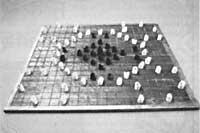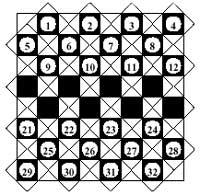Chinese Chess
1989/05/01 Angulo, Patxi | Artola, Xabier Iturria: Elhuyar aldizkaria
Introduction
From Chinese chess (or from "elephant chess" as they say), despite being known, we have very little bibliography.
He came to China from India. In the second half of the first century. The board, parts and movements were different. In 839 the general minister of the Tang lineage introduced today's cannons.
XI. By the end of the 20th century it had already achieved its current appearance. Few books have been preserved from this game and we have no news from its authors. The first book preserved in its entirety dates from the time of the Ming lineage. It features 70 short ways to finish the game. This book was published in 1522. The book, which can be considered a landmark in the bibliography, was published in 1632 by its author Jin-zhen Zhu. The book is titled "Oranges barruan sekretua" and is the last on this topic that came out in Ming. Once there was an orange tree and there grew an incredible orange. When they peeled the orange, they found inside two elders in chess. Hence the name of the book. This book collects the main achievements made in the Ming lineage.
The following important books on chess are from the beginning of this century.
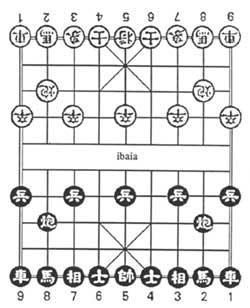
Boards and parts
The chess table consists of 9 vertical and 10 horizontal lines (see figure 1). The rupture of the seven interior vertical lines forms the river; the boundary of the northern and southern territories. On each side is the palace of the general of the territory, formed by four grids with their diagonals. The pieces are red and blue or black: red from the south and blue (or black) from the north. At first each part has 16 pieces: general, two chariots, two cannons, two counselors, two ministers (red) or two elephants (blue), two horses and five pawns (foot soldiers). The general, ministers or elephants, and pawns, are represented in both territories with different signs. (See table of tokens).
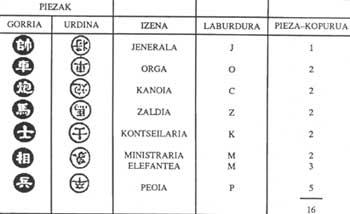
In the image you can see the initial location of the pieces. Keep in mind that the pieces are in the cutting points of the lines and not in the squares. Each piece can catch any piece of the enemy in order to catch its general.
The description of the parts is as follows:

It is the most important piece. If you lose you lose the game. When the general is attacked, he must be taken out of the attack in the next move or put some obstacle to the attacking piece with another piece.
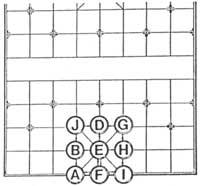
The general could move forward and backward: A, B, J, D, E, F, G, H, I (see figure 2). The general can move horizontally or vertically, but not diagonally (the objective of the diagonal lines is simply to explain the position of the palace). At most you can move to the contiguous cross. The general cannot move outside the palace (e.g. If the general is in position E you can move to B, D, H or F, but not to others, and if you are in position G only to D or H).
If any piece of the enemy moves to a position that is available to the General, it can be captured by the General.
You cannot keep the two generals in the same vertical line if there is no other piece between them (the General is able to take a big leap and catch the other).

The movement of the cart is the same as that of our chess tower, that is, it can move horizontally and vertically (but not diagonally), to any position of the board (it can even cross the river) if there are no obstacles in its way.
On your way you can catch any piece of the enemy.

In our chess there are no moving pieces of this piece. In reality, the movement is like that of the mass, but it can catch one piece of the enemy even if between the two there is another (any). In other words, the cannon can jump over a piece to catch the enemy's piece. If the cannon does not intend to catch the piece it cannot jump.

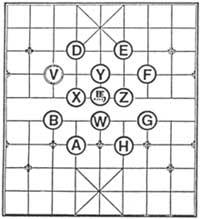
The movement of the horse is similar to that of our chess type L. E.g. The horse of Figure 3 can be moved to positions A, B, V, D, E, F, G and H (can even pass the river). But there is an obstacle that can limit the horse's legs. If the piece on either side is in X, the horse cannot move to B or V, but it can move anywhere else. Suppose also that in positions X and Y there are pieces but not in W and Z. The horse could move in this case to A, H, G or F. On the contrary, the movement to B and V is prevented by the piece of X and to D and F by the piece of Y. If in the worst case there are pieces in W, X, Y and Z, the horse can not move.

The counselor can only move diagonally. You can circulate inside the palace in positions A, D, E, F and G (see figure 4) moving from as far as possible to the contiguous cross.
At the beginning of the game the advisors will be placed in positions E and F. From these positions (and the same from G and D) the counselor can go to position A in the next move. From A to D, E, F or G.
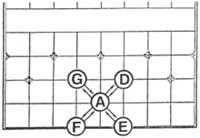

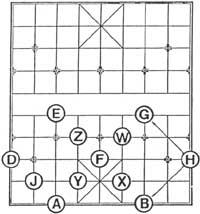
The Minister-Elephant cannot cross the river. At the beginning of the game they are placed in positions A and B (see figure 5). The Minister-Elephant could move diagonally and always through two squares. E.g. It can be moved from A to D or F; from H to G or B and from F to E, G, B or A. As in the case of the horse, there is an obstacle that can prevent the movement of the Minister-Elephant. If a piece on either side is on the diagonal of the Minister-Elephant side, it cannot be moved to that piece. E.g. If the Minister-Elephant is in position F and the pieces are in Z and X, the Minister-Elephant cannot go to E or B.

You can only move a time interval. Before crossing the river, only forward and vertically: Once crossed the river, both horizontally and vertically.
Never diagonally or backwards. Therefore, when the pawn reaches the last line on the opposite side, all it can do is walk to the right and left (moving only one position each time, of course). Unlike our chess, the pawn cannot be replaced by another chip when it reaches this last line. Like other pieces, you can catch any piece of the enemy that is at the place of your arrival.
Rules of the game
- The first movements are red. Each player has the possibility to make a single move in turn. Movement time is limited. If a player touches a piece, it must move. Chess: When a player gives a chess to the opposing General, that is, there is a danger that that General can be caught in the next move, he must proclaim chess. A player cannot be continually giving him chess. Specifically, a player cannot yield to the enemy with the same piece more than three times, without moving any other piece on a line (either side). E.g. In figure 6 the reds have just given chess to General Azul. The rubber trolley is not allowed Behind the general blue 4. Continuous use on lines 5 and 6. Matte Chess: When a player hands over a chess to the opposing General, the enemy cannot take the General out of the offensive or face chess with another piece interposed, the first player wins. Drowning: When a player cannot make a legitimate move with the remaining pieces, the player is "drowned". Drowning in Chinese chess is losing the game (not like in our chess). E.g. In figure 7 the blue general cannot move if he does not want to stay in the red horse chess. Nor can the blue cannon be moved. So he has made it the bluest. When the General of the Enemy cannot be hit, the game ends on the grid.
- Imagine that the reds use one piece to catch another blue (Figure 8). Initially the red piece is in position X and blue in position A. The red piece has endangered the blue piece. By leakage, the blue part moves to position B. Suppose the red piece follows you and moves to position Y. If then the blue piece moves back to position A, the red cannot move after the X. Specifically, this follow-up is not possible when the three conditions are met simultaneously:
- Both in A and B if the blue piece is unprotected (that is, if the red piece attracted the blue in any of its positions, the blues would have no other piece to contract the red). If blue uses two positions (no more or less) to escape the reds A and B.
- If the rubber uses two positions, X and Y, to follow the blue.
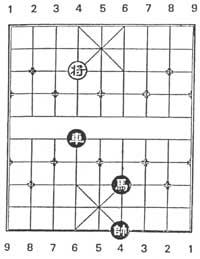
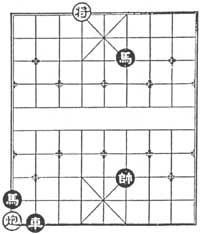
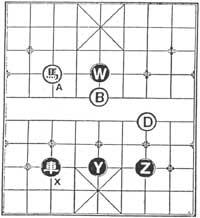
If any of the following conditions are not met, you can continue:
- a') If the blue part has some kind of protection (both in A and B), the piece's rubber can continuously pursue it. b') If you use more than two positions (A, B and D) to prevent blue pieces from being captured, the red piece can go to any position (Z) to follow the blue.
- c') If the red piece uses more than two positions in its pursuit behind the blue, it can also do so, regardless of what the blue does. E.g. If after moving the blue to B returns to A, the red could move to Y and then to W behind the blue.
Value and use of parts
The approximate value of the pieces is shown in the following table:
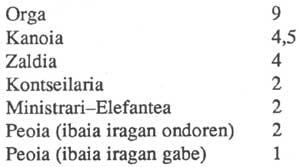
As you see, the General has not been given value. Because the General is the most important piece. If you lose you lose the game.
We will now explain roughly how to use parts, their importance, for what and when they can be used.
- General: shows its aggressive force at the end of the game. Otherwise, it weakens its territory by defending itself. Cart: "The one who does not move the car in the first three moves is not a good player and a car can vibrate 10 pieces," say the two proverbs. It is said that its value is greater at the beginning of the game than at the end. Cannon: Thanks to its rapid movement, it is a very important piece, both in defense and attack. As at the end of the game the number of pieces is smaller, its capture capacity decreases. Horse: Despite the difficulty of correctly using the horses, it is very important to protect the pawns and then attack. Counselor: His main responsibility is to take care of the General. Losing one of them can pose a great risk to the General. Elephant Minister: The Ministros-Elephants would be the outer layer of protection of the General (as the counselors are internal). For the General it is difficult to know which is the best pattern (Minister-Elephant or Counselor).
- Pawn: They are initially used to obstruct enemy parts. The central pawn is used for the defense of the palace; those of lines 3 and 7 to deal with attacks and those of lines 1 and 9 to avoid invasions. Pawns are often used as bridges for cannons when preparing terrifying attacks against the enemy.
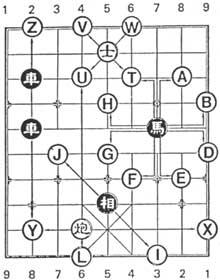
Writing
The movements of the pieces to carry the incidents of the game will be noted as follows:
As an example and based on Figure 9, the wording of some movements is presented below. The first letter indicates the piece we want to move, the contiguous number indicates the vertical line of the piece, the following letters the type of movement and the last numbers, in some cases the number of lines in which the piece must be moved and in others the number of the vertical line in which the piece must be left.
- Blue Canyon 4th line to U: C4 g6 (the blue cannon of line 4 moves to the liver or backwards 6 positions) Blue cannon of line 4 to position L: C4 to (the blue cannon on line 4 moves forward) Blue cannon from line 4 to position X: C4 h9 (the blue cannon of line 4 moves horizontally to line 9 vertical) Blue cannon of line 4 to position Y: C4 h2 (the blue cannon of line 4 moves horizontally to line 2 vertical) Red minister of line 5 to position 1: M5 a7 (the red minister of line 5 moves diagonally to line 7 vertical) rubber minister line 5 to position I: M5 g3 (the red minister of line 5 moves diagonally back to line 3 vertical) Blue counselor of line 5 to position U: KS A4 (the blue counselor of line 5 moves diagonally forward to line 4 vertical) Blue counselor of line 5 to position W: KS g6 (the blue counselor of line 5 moves diagonally towards the liver to line 6 vertical) to position A of the rubber horse of line 3: Z3 a2 (the red horse of the 3rd line, L-shaped, moves forward to the 2nd vertical line)
- Red horse 3rd line to D: Z3 gl (the rubber horse of line 3, L-shaped, moves towards the liver to the vertical line l)
The number of vertical lines has always been seen from the territory of the piece.
When two pieces of the same color are in the same vertical line, it is not enough with the previous writing, but it is necessary to indicate which option to choose. In this case we will write: in the image there are two red cars on line 8, we will call the most advanced the first, the other the second and it will be written like this:
11. First red trolley of line 8 to position Z:l0 a2 (the first trolley of line 8 moves 2 positions forward) 12. Second rubber trolley line 8 to position Y: b0 g4 (the second trolley of line 8 moves 4 positions towards the liver).
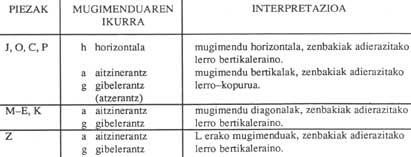

Gai honi buruzko eduki gehiago
Elhuyarrek garatutako teknologia



